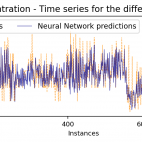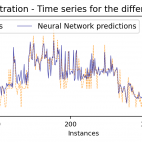Maria Grazia Zanoni, Ph.D. Candidate 35th cycle, University of Trento, DICAM
Ph.D. degree on 24/07/2023
The topic of my Phd Scholarship is concerning the effects of climate change and human exploitation on groundwater resources in a meso-scale watershed. Related to this
subject, a thorough analysis of the transport in surface water is mandatory. Certain environmental processes, such as contaminant transport in river or in groundwater may be sketched through the classical physic-based models or, alternatively through Machine Learning Based models and other data-driven models, that have shown to be a valid alternative to handle these complex processes, especially in systems that exhibit nonlinear behaviors. Machine Learning represents a subfield of Artificial Intelligence that involves the development of self-learning algorithms to gain knowledge from data in order to make predictions. For the appealing of Machine Learning, The purpose of my research, during this first year, has been to apply it to contaminant transport modeling in river.
Thus, I have studied three large European’s river basin (Adige, Ebro and Sava), with different climatic, soil and water use conditions. I have analyzed the long-term time series of water quality data from 1990 to 2015 in order to investigate the relationships between water quality parameters (such as the concentration of Arsenic or Sulphates) and the main factors controlling them, the drivers (including percentage of land use, monthly aggregated streamflow and temperature of air). I have modeled temporal trend of these parameters with different machine learning techniques. In the pictures the comparison between Neural Network predictions and experimental values, for the different stations of the Adige’s basin, is viewable, for Arsenic and Chloride. Furthermore, I have investigated the roles played by the drivers controlling the surface water dynamics and I have examined the geographical and climatic effect on the predictions. This initial elaboration has shown that with these techniques is possible to reach a relatively high accuracy in the prediction of the variables, even with a few information. In the following steps the modeling framework to a meso-scale watershed will be considered and the introduction of a physical constraint will be implemented.


